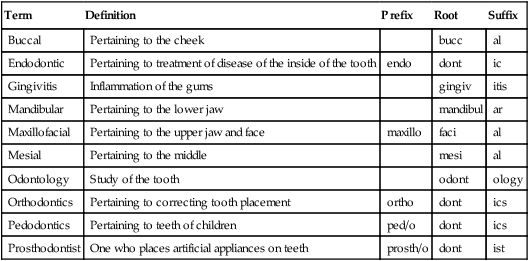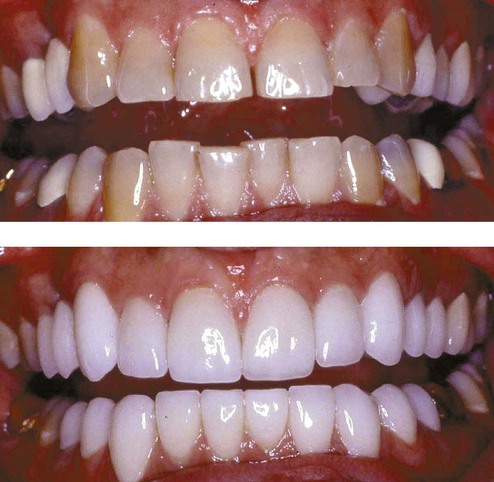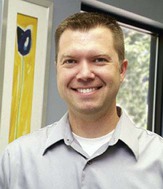Chapter 26 (HI-jeen) Proper care of the mouth and teeth for maintenance of health and the prevention of disease *A transition syllable or vowel may be added to or deleted from the word parts to make the combining form. The dental team includes the dentist, dental hygienist, dental assistant, and dental laboratory technician (Box 26-1). The goal of the dental team is to provide optimal care of the oral cavity for all patients. Dental team members work in a variety of settings, including group practice, specialty practice, schools, government or community clinics, and dental insurance and supply companies (Table 26-1). TABLE 26-1 Dental Career Educational Cost and Earnings *http://www.ccd.edu/DentalHygiene/Expenses.aspx. The role of the dentist has changed greatly because improved methods of dental care and nutrition have reduced the number of caries. Dentists now perform a variety of services, including public education directed to prevent tooth decay, detection of disease such as cancer, cosmetic improvement of appearance, and correction of oral problems such as misaligned teeth and jaws (Fig. 26-1). Some dentists perform surgery to correct facial and dental deformities caused by accidents or birth defects. Pain control and anesthesia in dentistry have become two of the roles of the professional, because many people become anxious and even phobic when needing dental care. Types of anesthesia that may be administered include local anesthesia, sedation, and general anesthesia. Some sedation may even cause retrograde amnesia or the inability to remember the treatment. Dentistry offers nine specialties that allow practice in specific areas:
Dental Careers
 Define at least 10 terms relating to dental health care.
Define at least 10 terms relating to dental health care.
 Specify the role of the dentist, dental hygienist, dental assistant, and dental laboratory technician, including personal qualities, levels of education, and credentialing requirements.
Specify the role of the dentist, dental hygienist, dental assistant, and dental laboratory technician, including personal qualities, levels of education, and credentialing requirements.
 Identify the difference between the dentition of the child and that of the adult.
Identify the difference between the dentition of the child and that of the adult.
 Identify at least five structures of the oral cavity.
Identify at least five structures of the oral cavity.
 Describe the location, structure, and function of four types of teeth.
Describe the location, structure, and function of four types of teeth.
 Chart at least three types of dental variations using a selected method of charting.
Chart at least three types of dental variations using a selected method of charting.
 Describe methods of prevention and detection of caries and periodontal disease.
Describe methods of prevention and detection of caries and periodontal disease.
 Describe techniques of brushing and flossing to promote dental health.
Describe techniques of brushing and flossing to promote dental health.
Term
Definition
Prefix
Root
Suffix
Buccal
Pertaining to the cheek
bucc
al
Endodontic
Pertaining to treatment of disease of the inside of the tooth
endo
dont
ic
Gingivitis
Inflammation of the gums
gingiv
itis
Mandibular
Pertaining to the lower jaw
mandibul
ar
Maxillofacial
Pertaining to the upper jaw and face
maxillo
faci
al
Mesial
Pertaining to the middle
mesi
al
Odontology
Study of the tooth
odont
ology
Orthodontics
Pertaining to correcting tooth placement
ortho
dont
ics
Pedodontics
Pertaining to teeth of children
ped/o
dont
ics
Prosthodontist
One who places artificial appliances on teeth
prosth/o
dont
ist

Careers

Dentist
 Endodontics: treatment of disease of the dental pulp, usually with root canal
Endodontics: treatment of disease of the dental pulp, usually with root canal
 Oral and maxillofacial surgery: extraction and treatment of injury, disease, and deformity of the mouth, such as cleft palate
Oral and maxillofacial surgery: extraction and treatment of injury, disease, and deformity of the mouth, such as cleft palate
 Oral pathology: laboratory testing and biopsy to diagnose oral conditions
Oral pathology: laboratory testing and biopsy to diagnose oral conditions
 Orthodontics: prescription and fitting of braces to correct misaligned teeth or jaws
Orthodontics: prescription and fitting of braces to correct misaligned teeth or jaws
 Pedodontics: prevention of disease and decay and therapeutic care of children’s teeth from birth through adolescence
Pedodontics: prevention of disease and decay and therapeutic care of children’s teeth from birth through adolescence
 Periodontics: treatment of gum disease and education for prevention
Periodontics: treatment of gum disease and education for prevention
 Prosthodontics: design and fitting of bridgework and dentures, as well as substitutes for missing teeth or tissue
Prosthodontics: design and fitting of bridgework and dentures, as well as substitutes for missing teeth or tissue
 Public health dentistry: promotion of prevention and treatment of dental disease
Public health dentistry: promotion of prevention and treatment of dental disease
 Oral and maxillofacial radiology: includes the diagnosis and treatment of oral and maxillofacial disorders by using radiation
Oral and maxillofacial radiology: includes the diagnosis and treatment of oral and maxillofacial disorders by using radiation
Dental Careers
Get Clinical Tree app for offline access





